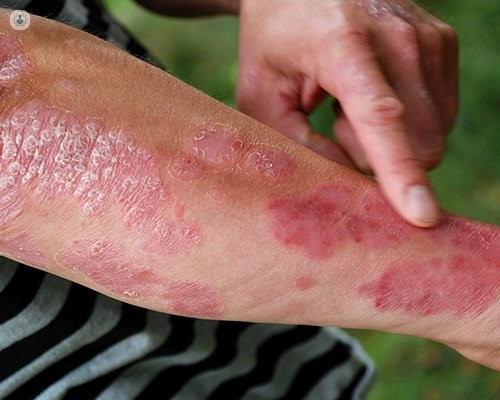Patch tests
Dr Pamela McHenry - Dermatology
Created on: 11-13-2012
Updated on: 05-30-2023
Edited by: Conor Lynch
What is patch testing?
Patch testing, sometimes referred to as epicutaneous skin testing, is a test used to find out what allergen is causing inflammation upon skin contact.

What does patch testing involve?
Firstly, the patient will speak to the specialist to explain when the skin inflammation started, how it’s progressed, treatments tried, family history, work, and any other factors that may influence it. The patch itself is a polyethylene-coated aluminium foil. In the centre, there is a paper filter disc where the potential allergens are placed.
The patches are normally placed in strips on the upper back. It is recommended that the area shouldn’t be washed nor should exercises that cause a lot of sweating be performed.
After 48 hours, the patches are taken off and analysed after an hour. 48 hours after they have been taken off, the final reading is done.
What is it for?
These tests are done to see if a certain substance is causing the skin to be irritated. This type of skin inflammation is known as contact dermatitis. There are two types, one which is caused by irritants, which has no relation to an immune disorder, and allergic contact dermatitis, which is an immune response.
When a person has dermatitis that has started recently or constant eczema, the dermatologist may think it is allergic contact dermatitis. There are some cases in which using a prescribed cream has a reaction that seems like dermatitis, raising the suspicion that the allergic reaction to the cream is what is aggravating the dermatitis.
Patch tests are the best way for a specialist to tell if certain substances are aggravating the dermatitis.
How can you prepare patch testing?
The patient should speak to the specialist and tell them in as much detail as possible how the problem started, as well as where and when the rash started. They should also inform of any and all treatments tried, family history, and products used in everyday life.
What does it feel like during the procedure?
Patch tests are placed on the patient's back for at least 24 hours. The procedure is painless and the patient will only have mild discomfort at having a patch stuck on their back and the inconvenience of not being able to wash the area or take part in activities that may cause a lot of sweating.
What would a “bad” result in a patch test mean?
Any reactions will be noted by the specialist in the following way:
- Negative reaction
- Doubtful reaction (mild redness)
- Weak positive reaction (red skin)
- Intensely positive reaction
- Irritant reaction
There are a number of situations in which a patch test will have unexpected or abnormal results due to the patient taking systemic or topical corticosteroids, avoiding sun exposure, and avoiding doing the patch test on hot days, as the results may be affected.







